engine RENAULT TWINGO 2009 2.G Electrical Equipment - Petrol Injection Owner's Manual
[x] Cancel search | Manufacturer: RENAULT, Model Year: 2009, Model line: TWINGO, Model: RENAULT TWINGO 2009 2.GPages: 348
Page 31 of 348
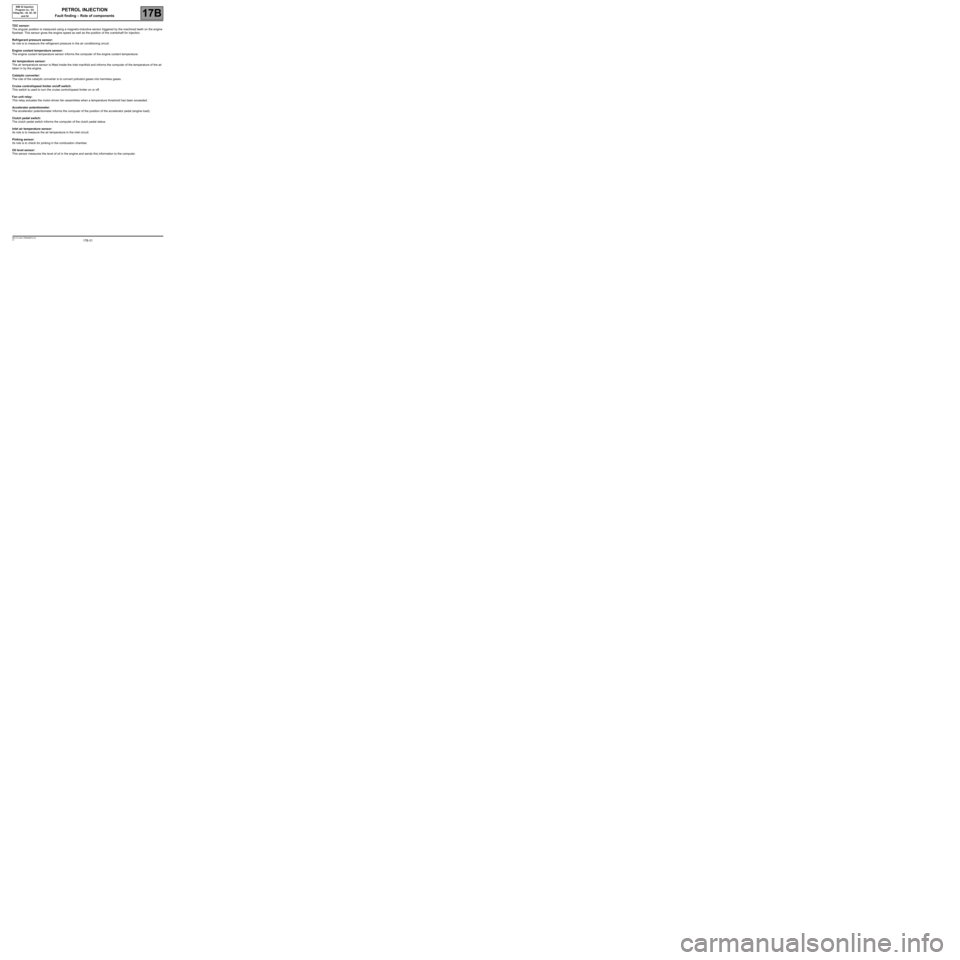
17B-31V7 MR-413-X44-17B000$070.mif
PETROL INJECTION
Fault finding – Role of components17B
SIM 32 Injection
Program no.: D3
Vdiag No.: 44, 4C, 50
and 54
TDC sensor:
The angular position is measured using a magneto-inductive sensor triggered by the machined teeth on the engine
flywheel. This sensor gives the engine speed as well as the position of the crankshaft for injection.
Refrigerant pressure sensor:
Its role is to measure the refrigerant pressure in the air conditioning circuit.
Engine coolant temperature sensor:
The engine coolant temperature sensor informs the computer of the engine coolant temperature.
Air temperature sensor:
The air temperature sensor is fitted inside the inlet manifold and informs the computer of the temperature of the air
taken in by the engine.
Catalytic converter:
The role of the catalytic converter is to convert pollutant gases into harmless gases.
Cruise control/speed limiter on/off switch:
This switch is used to turn the cruise control/speed limiter on or off.
Fan unit relay:
This relay actuates the motor-driven fan assemblies when a temperature threshold has been exceeded.
Accelerator potentiometer:
The accelerator potentiometer informs the computer of the position of the accelerator pedal (engine load).
Clutch pedal switch:
The clutch pedal switch informs the computer of the clutch pedal status.
Inlet air temperature sensor:
Its role is to measure the air temperature in the inlet circuit.
Pinking sensor:
Its role is to check for pinking in the combustion chamber.
Oil level sensor:
This sensor measures the level of oil in the engine and sends this information to the computer.
Page 32 of 348
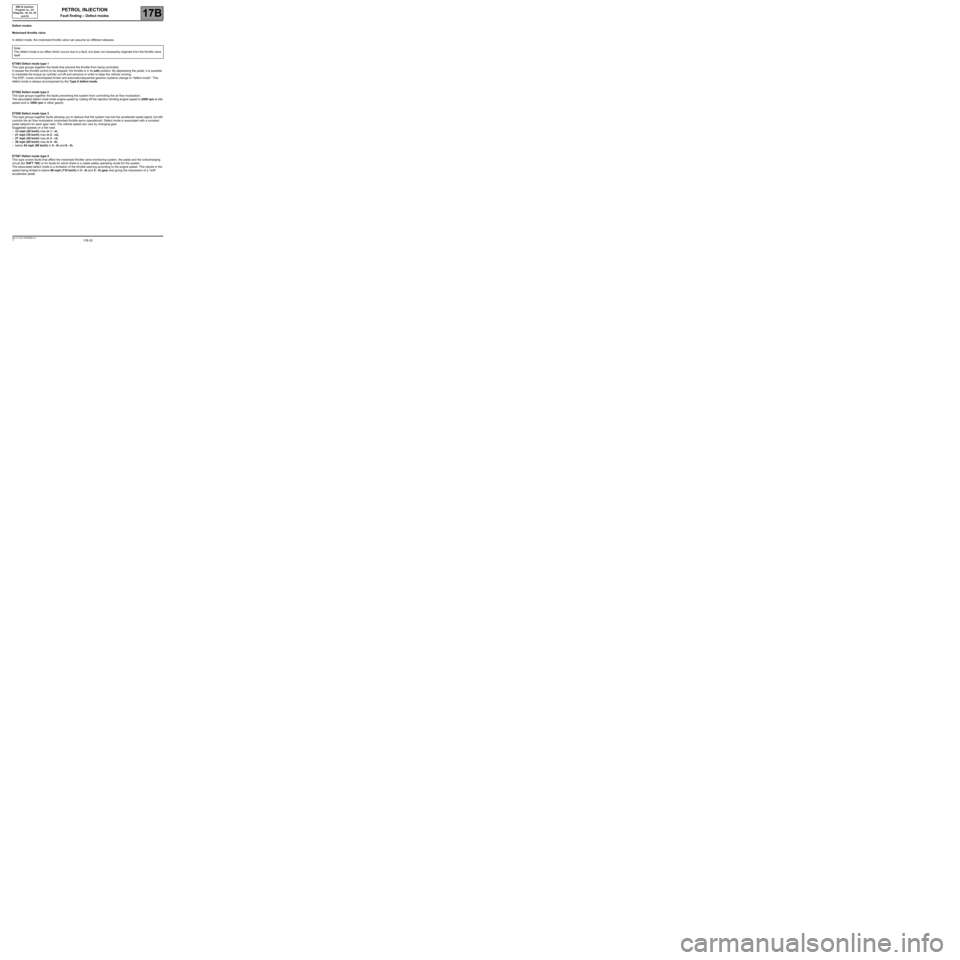
17B-32V7 MR-413-X44-17B000$080.mif
17B
SIM 32 Injection
Program no.: D3
Vdiag No.: 44, 4C, 50
and 54
Defect modes
Motorised throttle valve
In defect mode, the motorised throttle valve can assume six different statuses.
ET564 Defect mode type 1
This type groups together the faults that prevent the throttle from being controlled.
It causes the throttle control to be stopped: the throttle is in its safe position. By depressing the pedal, it is possible
to modulate the torque by cylinder cut-off and advance in order to keep the vehicle running.
The ESP, cruise control/speed limiter and automatic/sequential gearbox systems change to "defect mode". This
defect mode is always accompanied by the Type 2 defect mode.
ET565 Defect mode type 2
This type groups together the faults preventing the system from controlling the air flow modulation.
The associated defect mode limits engine speed by cutting off the injection (limiting engine speed to 2400 rpm at idle
speed and to 3500 rpm in other gears).
ET566 Defect mode type 3
This type groups together faults allowing you to deduce that the system has lost the accelerator pedal signal, but still
controls the air flow modulation (motorised throttle servo operational). Defect mode is associated with a constant
pedal setpoint for each gear ratio. The vehicle speed can vary by changing gear.
Suggested speeds on a flat road:
–12 mph (20 km/h) max in 1 - st,
–21 mph (35 km/h) max in 2 - nd,
–27 mph (45 km/h) max in 3 - rd,
–39 mph (65 km/h) max in 4 - th,
–below 54 mph (90 km/h) in 5 - th and 6 - th.
ET567 Defect mode type 4
This type covers faults that affect the motorised throttle valve monitoring system, the pedal and the turbocharging
circuit (for D4FT 780) or for faults for which there is a viable safety operating mode for the system.
The associated defect mode is a limitation of the throttle opening according to the engine speed. This results in the
speed being limited to below 66 mph (110 km/h) in 5 - th and 6 - th gear and giving the impression of a "soft"
accelerator pedal.Note:
This defect mode is an effect which occurs due to a fault, but does not necessarily originate from the throttle valve
itself.
PETROL INJECTION
Fault finding – Defect modes
Page 33 of 348
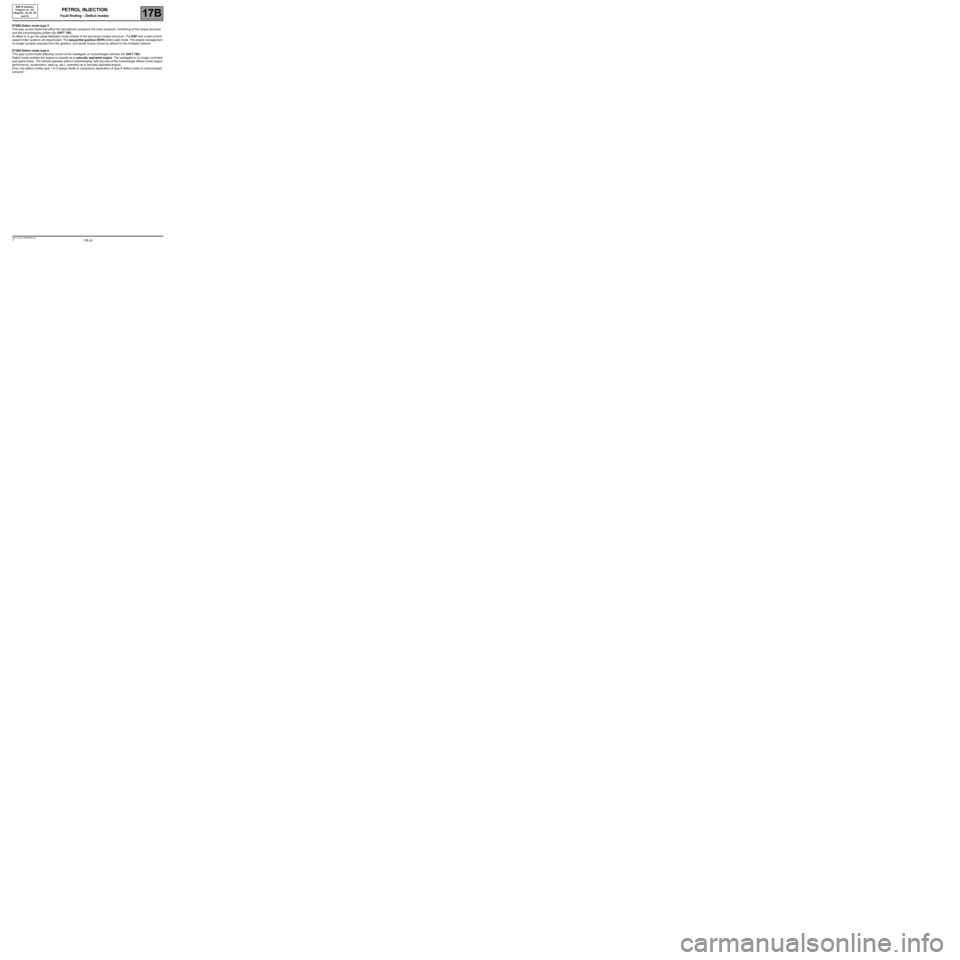
17B-33V7 MR-413-X44-17B000$080.mif
PETROL INJECTION
Fault finding – Defect modes17B
SIM 32 Injection
Program no.: D3
Vdiag No.: 44, 4C, 50
and 54
ET568 Defect mode type 5
This type covers faults that affect the atmospheric pressure, the turbo pressure, monitoring of the torque structure
and the turbocharging system (for D4FT 780).
Its effect is to go into pedal feedback mode instead of the permanent torque structure. The ESP and cruise control/
speed limiter systems are deactivated. The sequential gearbox (BVR) enters safe mode. The engine management
no longer accepts requests from the gearbox, and sends torque values by default to the multiplex network.
ET569 Defect mode type 6
This type covers faults affecting control of the wastegate on turbocharged vehicles (for D4FT 780).
Defect mode enables the engine to operate as a naturally aspirated engine. The wastegate is no longer controlled
and opens freely. The vehicle operates without turbocharging: with the loss of the turbocharger effects (brisk engine
performance, acceleration, take-up, etc.); operation as a naturally aspirated engine.
Entry into defect modes type 1 to 5 always leads to compulsory application of type 6 defect mode on turbocharged
versions*.
Page 35 of 348
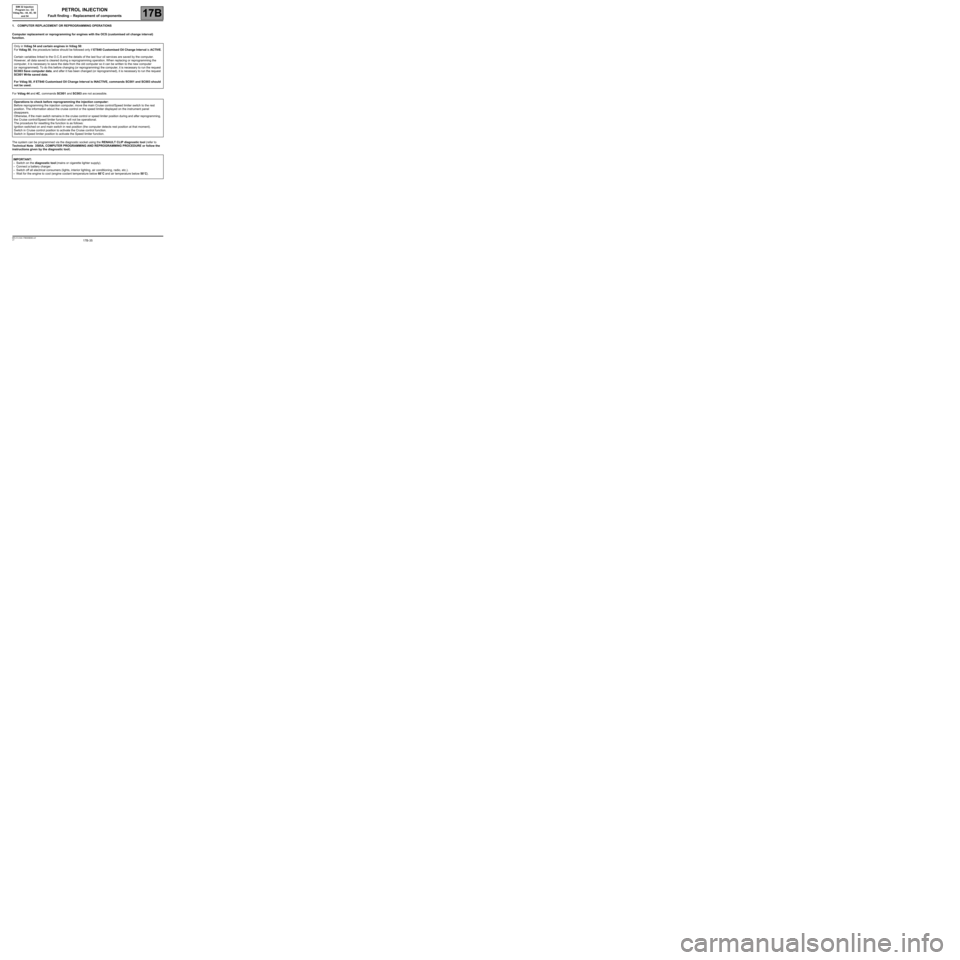
17B-35V7 MR-413-X44-17B000$090.mif
17B
SIM 32 Injection
Program no.: D3
Vdiag No.: 44, 4C, 50
and 54
1. COMPUTER REPLACEMENT OR REPROGRAMMING OPERATIONS
Computer replacement or reprogramming for engines with the OCS (customised oil change interval)
function.
For Vdiag 44 and 4C, commands SC001 and SC003 are not accessible.
The system can be programmed via the diagnostic socket using the RENAULT CLIP diagnostic tool (refer to
Technical Note 3585A, COMPUTER PROGRAMMING AND REPROGRAMMING PROCEDURE or follow the
instructions given by the diagnostic tool). Only in Vdiag 54 and certain engines in Vdiag 50:
For Vdiag 50, the procedure below should be followed only if ET840 Customised Oil Change Interval is ACTIVE.
Certain variables linked to the O.C.S and the details of the last four oil services are saved by the computer.
However, all data saved is cleared during a reprogramming operation. When replacing or reprogramming the
computer, it is necessary to save the data from the old computer so it can be written to the new computer
(or reprogrammed). To do this before changing (or reprogramming) the computer, it is necessary to run the request
SC003 Save computer data, and after it has been changed (or reprogrammed), it is necessary to run the request
SC001 Write saved data.
For Vdiag 50, if ET840 Customised Oil Change Interval is INACTIVE, commands SC001 and SC003 should
not be used.
Operations to check before reprogramming the injection computer:
Before reprogramming the injection computer, move the main Cruise control/Speed limiter switch to the rest
position. The information about the cruise control or the speed limiter displayed on the instrument panel
disappears.
Otherwise, if the main switch remains in the cruise control or speed limiter position during and after reprogramming,
the Cruise control/Speed limiter function will not be operational.
The procedure for resetting the function is as follows:
Ignition switched on and main switch in rest position (the computer detects rest position at that moment).
Switch in Cruise control position to activate the Cruise control function.
Switch in Speed limiter position to activate the Speed limiter function.
IMPORTANT:
–Switch on the diagnostic tool (mains or cigarette lighter supply).
–Connect a battery charger.
–Switch off all electrical consumers (lights, interior lighting, air conditioning, radio, etc.).
–Wait for the engine to cool (engine coolant temperature below 60˚C and air temperature below 50˚C).
PETROL INJECTION
Fault finding – Replacement of components
Page 36 of 348
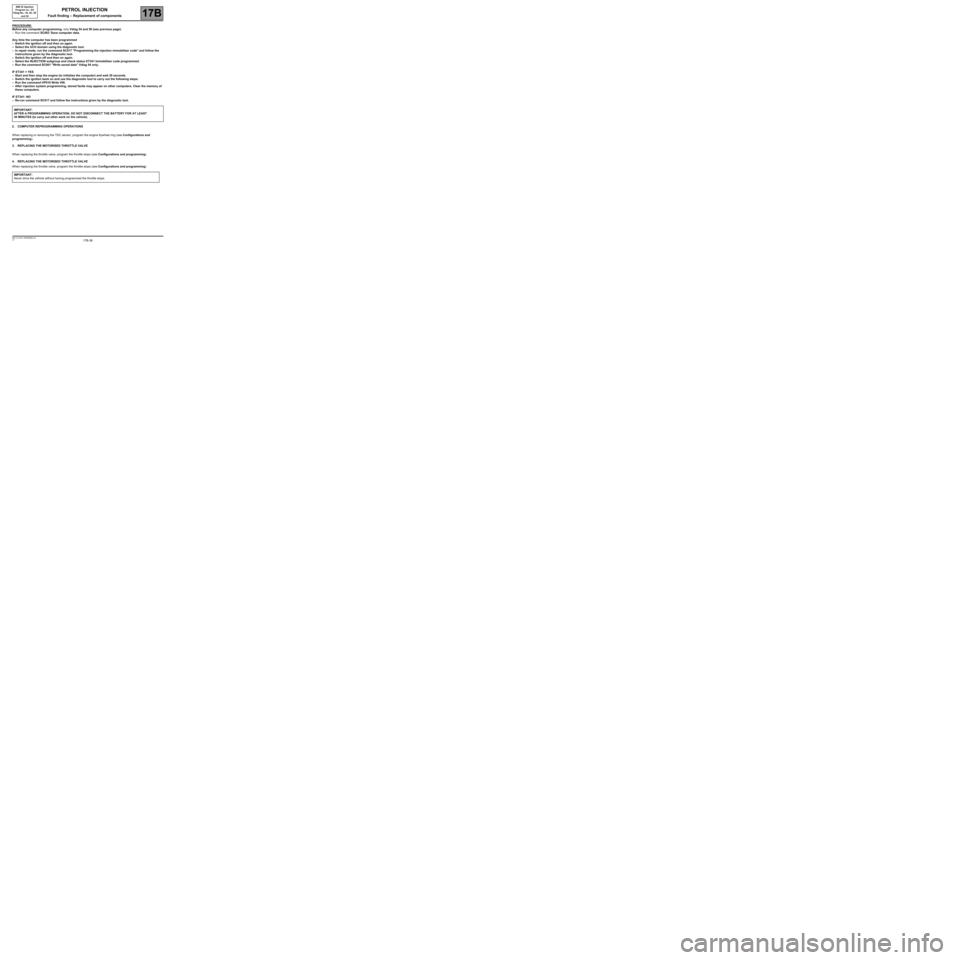
17B-36V7 MR-413-X44-17B000$090.mif
PETROL INJECTION
Fault finding – Replacement of components17B
SIM 32 Injection
Program no.: D3
Vdiag No.: 44, 4C, 50
and 54
PROCEDURE:
Before any computer programming, only Vdiag 54 and 50 (see previous page):
–Run the command SC003 'Save computer data.
Any time the computer has been programmed
–Switch the ignition off and then on again.
–Select the UCH domain using the diagnostic tool.
–In repair mode, run the command SC017 "Programming the injection immobiliser code" and follow the
instructions given by the diagnostic tool.
–Switch the ignition off and then on again.
–Select the INJECTION subgroup and check status ET341 Immobiliser code programmed.
–Run the command SC001 ''Write saved data" Vdiag 54 only.
IF ET341 = YES
–Start and then stop the engine (to initialise the computer) and wait 30 seconds.
–Switch the ignition back on and use the diagnostic tool to carry out the following steps:
–Run the command VP010 Write VIN.
–After injection system programming, stored faults may appear on other computers. Clear the memory of
these computers.
IF ET341: NO
–Re-run command SC017 and follow the instructions given by the diagnostic tool.
2. COMPUTER REPROGRAMMING OPERATIONS
When replacing or removing the TDC sensor, program the engine flywheel ring (see Configurations and
programming).
3. REPLACING THE MOTORISED THROTTLE VALVE
When replacing the throttle valve, program the throttle stops (see Configurations and programming).
4. REPLACING THE MOTORISED THROTTLE VALVE
When replacing the throttle valve, program the throttle stops (see Configurations and programming). IMPORTANT:
AFTER A PROGRAMMING OPERATION, DO NOT DISCONNECT THE BATTERY FOR AT LEAST
30 MINUTES (to carry out other work on the vehicle).
IMPORTANT:
Never drive the vehicle without having programmed the throttle stops.
Page 39 of 348
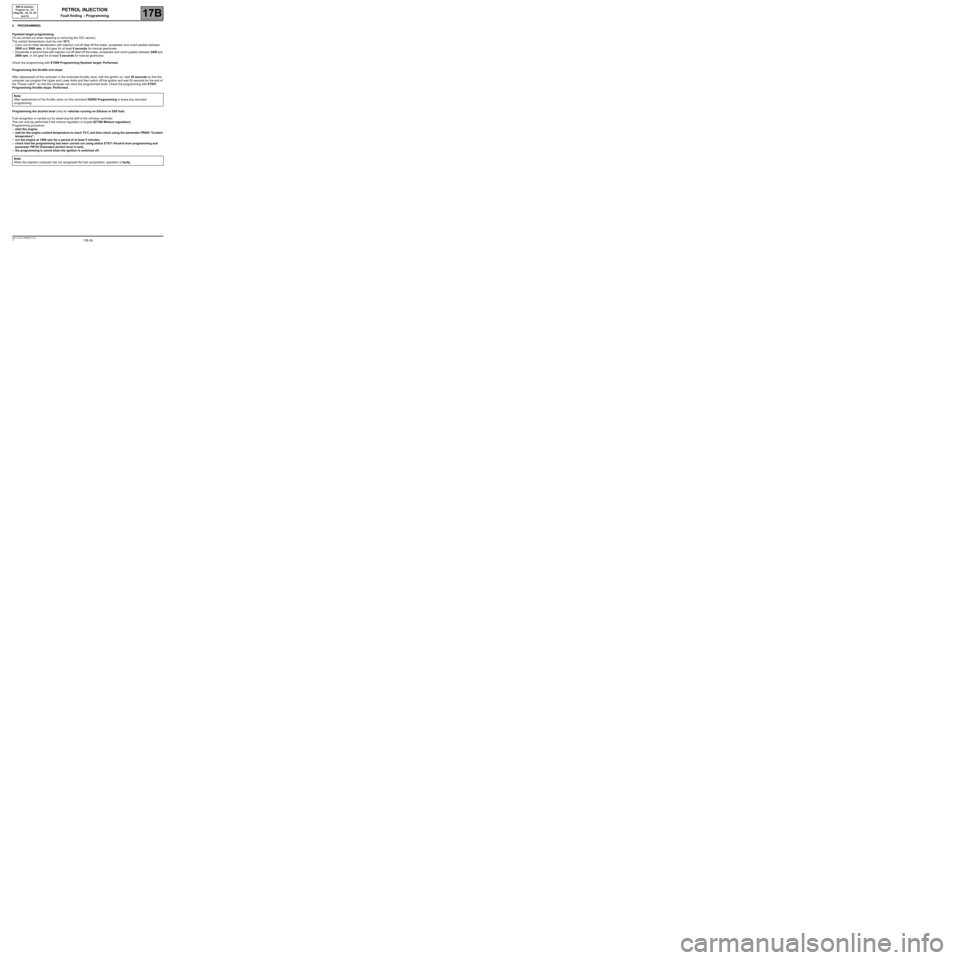
17B-39V7 MR-413-X44-17B000$110.mif
17B
SIM 32 Injection
Program no.: D3
Vdiag No.: 44, 4C, 50
and 54
2. PROGRAMMING
Flywheel target programming
(To be carried out when replacing or removing the TDC sensor).
The coolant temperature must be over 35˚C.
–Carry out an initial deceleration with injection cut-off (feet off the brake, accelerator and clutch pedals) between
3500 and 3000 rpm, in 3rd gear for at least 5 seconds for manual gearboxes.
–Decelerate a second time with injection cut-off (feet off the brake, accelerator and clutch pedals) between 2400 and
2000 rpm, in 3rd gear for at least 5 seconds for manual gearboxes.
Check the programming with ET089 Programming flywheel target: Performed.
Programming the throttle end stops
After replacement of the computer or the motorised throttle valve, with the ignition on, wait 30 seconds so that the
computer can program the Upper and Lower limits and then switch off the ignition and wait 30 seconds for the end of
the "Power Latch", so that the computer can store the programmed limits. Check the programming with ET051
Programming throttle stops: Performed.
Programming the alcohol level (only for vehicles running on Ethanol or E85 fuel)
Fuel recognition is carried out by observing the drift of the richness controller.
This can only be performed if the mixture regulation is looped (ET300 Mixture regulation).
Programming procedure:
–start the engine,
–wait for the engine coolant temperature to reach 75˚C and then check using the parameter PR064 "Coolant
temperature",
–run the engine at 1500 rpm for a period of at least 5 minutes,
–check that the programming has been carried out using status ET671 Alcohol level programming and
parameter PR743 Estimated alcohol level in tank,
–the programming is saved when the ignition is switched off. Note:
After replacement of the throttle valve run the command RZ005 Programming to erase any recorded
programming.
Note:
When the injection computer has not recognised the fuel composition, operation is faulty.
PETROL INJECTION
Fault finding – Programming
Page 42 of 348
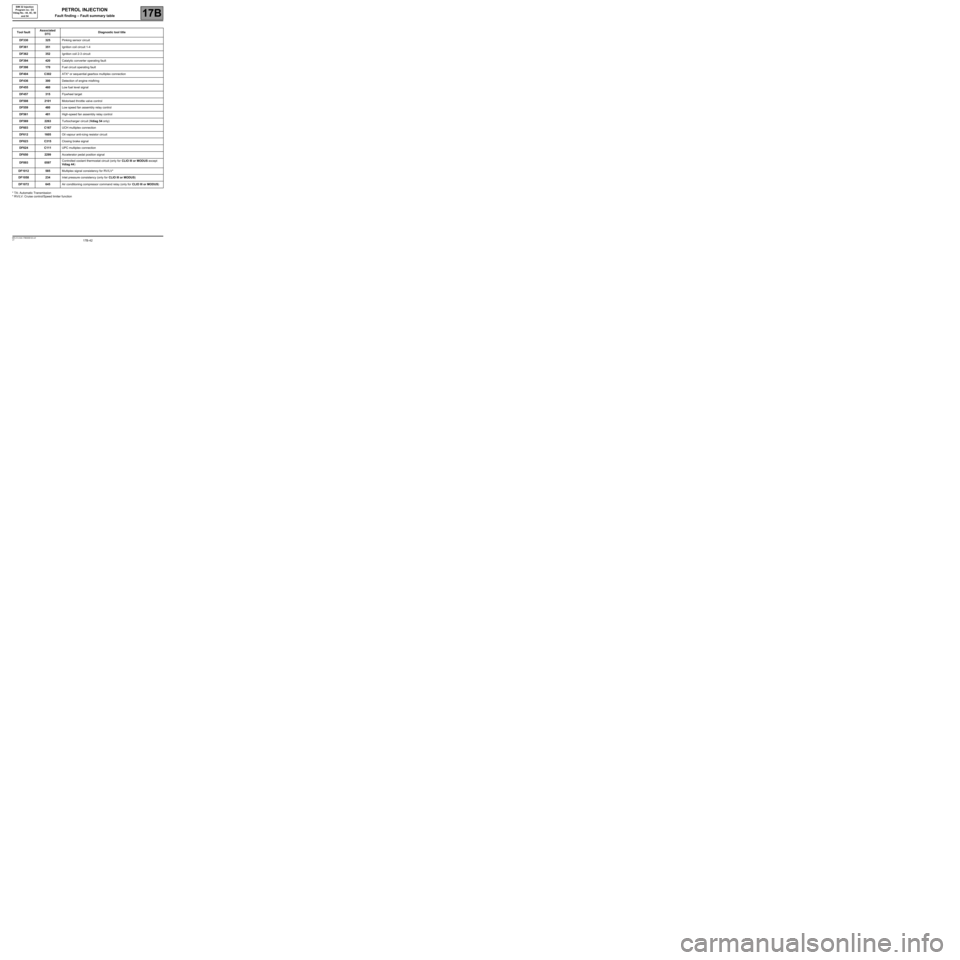
17B-42V7 MR-413-X44-17B000$120.mif
PETROL INJECTION
Fault finding – Fault summary table17B
SIM 32 Injection
Program no.: D3
Vdiag No.: 44, 4C, 50
and 54
* TA: Automatic Transmission
* RV/LV: Cruise control/Speed limiter function
Tool faultAssociated
DTCDiagnostic tool title
DF330325Pinking sensor circuit
DF361351Ignition coil circuit 1-4
DF362352Ignition coil 2-3 circuit
DF394420Catalytic converter operating fault
DF398170Fuel circuit operating fault
DF404C302ATX* or sequential gearbox multiplex connection
DF436300Detection of engine misfiring
DF455460Low fuel level signal
DF457315Flywheel target
DF5082101Motorised throttle valve control
DF559480Low speed fan assembly relay control
DF561481High-speed fan assembly relay control
DF5692263Turbocharger circuit (Vdiag 54 only)
DF603C167UCH multiplex connection
DF6121605Oil vapour anti-icing resistor circuit
DF623C315Closing brake signal
DF624C111UPC multiplex connection
DF6502299Accelerator pedal position signal
DF8930597Controlled coolant thermostat circuit (only for CLIO III or MODUS except
Vdiag 44)
DF1012585Multiplex signal consistency for RV/LV*
DF1058234Inlet pressure consistency (only for CLIO III or MODUS)
DF1072645Air conditioning compressor command relay (only for CLIO III or MODUS)
Page 43 of 348
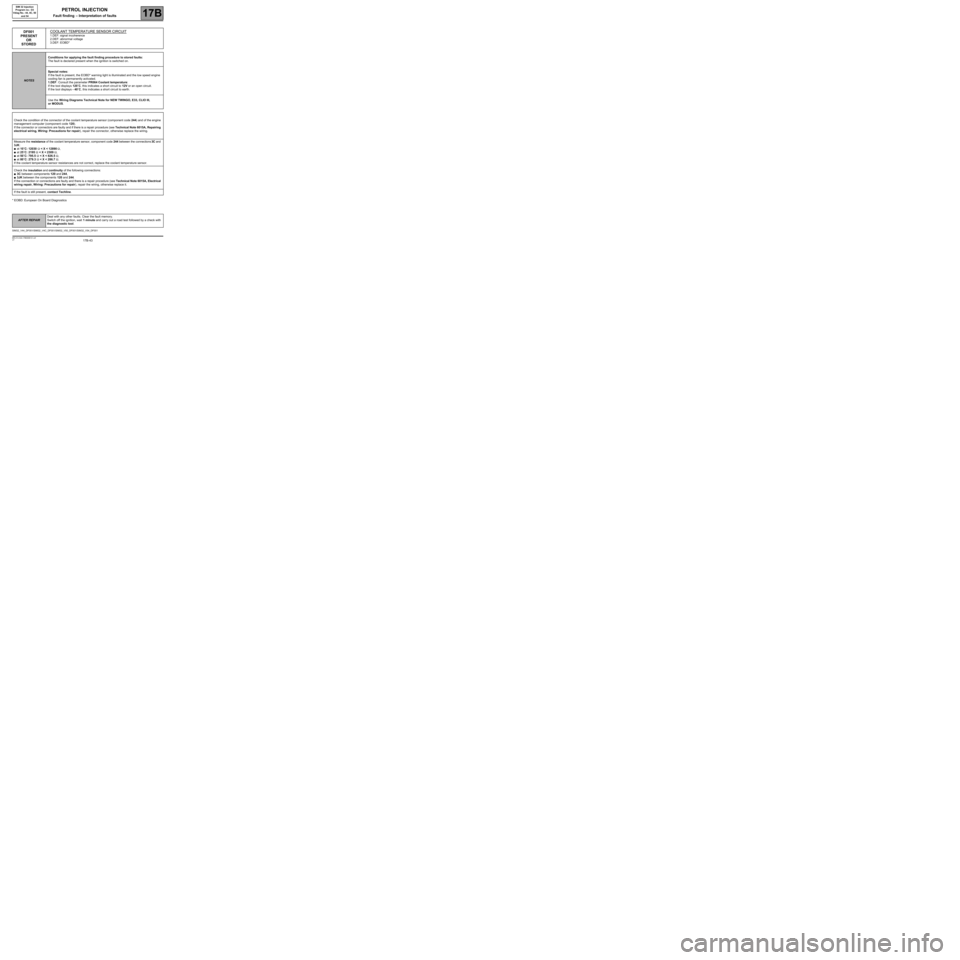
17B-43V7 MR-413-X44-17B000$131.mif
17B
SIM 32 Injection
Program no.: D3
Vdiag No.: 44, 4C, 50
and 54
* EOBD: European On Board Diagnostics
DF001
PRESENT
OR
STOREDCOOLANT TEMPERATURE SENSOR CIRCUIT
1.DEF: signal incoherence
2.DEF: abnormal voltage
3.DEF: EOBD*
NOTESConditions for applying the fault finding procedure to stored faults:
The fault is declared present when the ignition is switched on.
Special notes:
If the fault is present, the EOBD* warning light is illuminated and the low speed engine
cooling fan is permanently activated.
1.DEF: Consult the parameter PR064 Coolant temperature:
If the tool displays 120˚C, this indicates a short circuit to 12V or an open circuit.
If the tool displays - 40˚C, this indicates a short circuit to earth.
Use the Wiring Diagrams Technical Note for NEW TWINGO, E33, CLIO III,
or MODUS.
Check the condition of the connector of the coolant temperature sensor (component code 244) and of the engine
management computer (component code 120).
If the connector or connectors are faulty and if there is a repair procedure (see Technical Note 6015A, Repairing
electrical wiring, Wiring: Precautions for repair), repair the connector, otherwise replace the wiring.
Measure the resistance of the coolant temperature sensor, component code 244 between the connections 3C and
3JK:
●at 10˚C: 12030 Ω < X < 12890 Ω,
●at 25˚C: 2195 Ω < X < 2309 Ω,
●at 50˚C: 795.5 Ω < X < 826.5 Ω,
●at 80˚C: 279.3 Ω < X < 286.7 Ω.
If the coolant temperature sensor resistances are not correct, replace the coolant temperature sensor.
Check the insulation and continuity of the following connections:
●3C between components 120 and 244,
●3JK between the components 120 and 244.
If the connection or connections are faulty and there is a repair procedure (see Technical Note 6015A, Electrical
wiring repair, Wiring: Precautions for repair), repair the wiring, otherwise replace it.
If the fault is still present, contact Techline.
SIM32_V44_DF001/SIM32_V4C_DF001/SIM32_V50_DF001/SIM32_V54_DF001
PETROL INJECTION
Fault finding – Interpretation of faults
AFTER REPAIRDeal with any other faults. Clear the fault memory.
Switch off the ignition, wait 1 minute and carry out a road test followed by a check with
the diagnostic tool.
Page 44 of 348
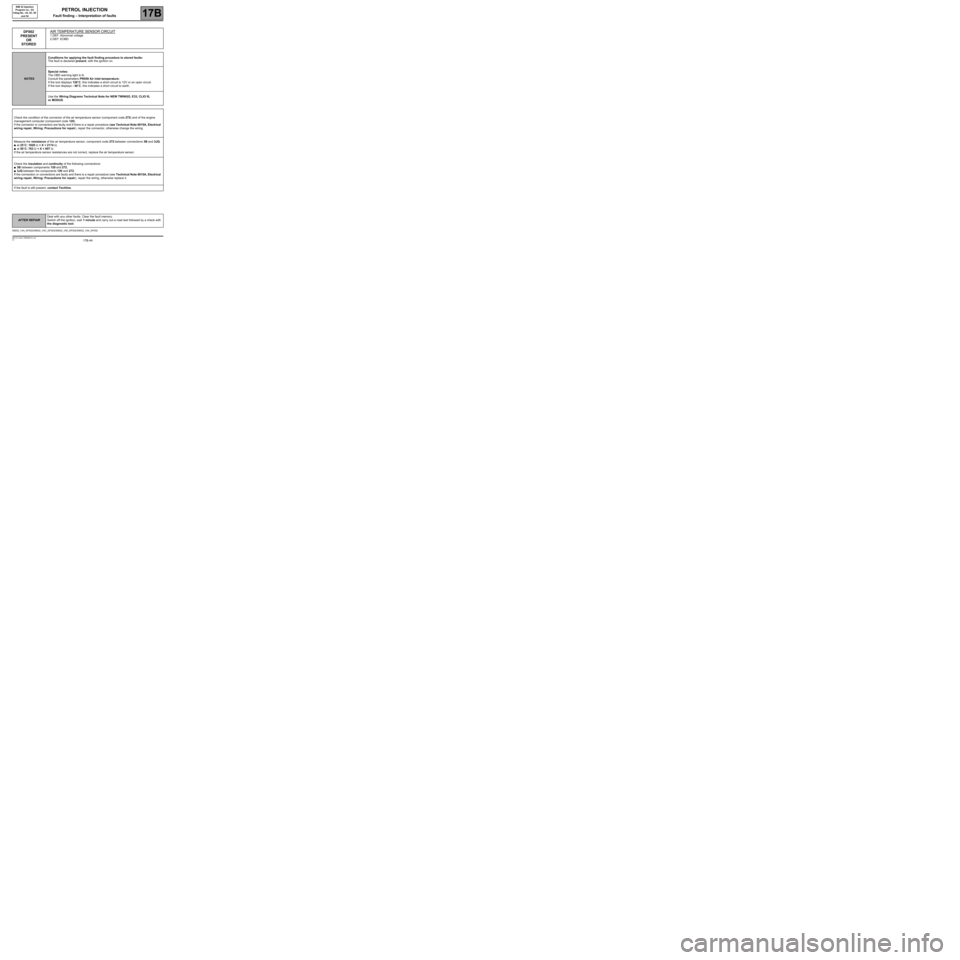
17B-44V7 MR-413-X44-17B000$131.mif
PETROL INJECTION
Fault finding – Interpretation of faults17B
SIM 32 Injection
Program no.: D3
Vdiag No.: 44, 4C, 50
and 54
DF002
PRESENT
OR
STOREDAIR TEMPERATURE SENSOR CIRCUIT
1.DEF: Abnormal voltage
2.DEF: EOBD
NOTESConditions for applying the fault finding procedure to stored faults:
The fault is declared present, with the ignition on.
Special notes:
The OBD warning light is lit.
Consult the parameters PR059 Air inlet temperature:
If the tool displays 120˚C, this indicates a short circuit to 12V or an open circuit.
If the tool displays - 40˚C, this indicates a short circuit to earth.
Use the Wiring Diagrams Technical Note for NEW TWINGO, E33, CLIO III,
or MODUS.
Check the condition of the connector of the air temperature sensor (component code 272) and of the engine
management computer (component code 120).
If the connector or connectors are faulty and if there is a repair procedure (see Technical Note 6015A, Electrical
wiring repair, Wiring: Precautions for repair), repair the connector, otherwise change the wiring.
Measure the resistance of the air temperature sensor, component code 272 between connections 3B and 3JQ:
●at 25˚C: 1928 Ω < X < 2174 Ω,
●at 50˚C: 763 Ω < X < 857 Ω.
If the air temperature sensor resistances are not correct, replace the air temperature sensor.
Check the insulation and continuity of the following connections:
●3B between components 120 and 272,
●3JQ between the components 120 and 272.
If the connection or connections are faulty and there is a repair procedure (see Technical Note 6015A, Electrical
wiring repair, Wiring: Precautions for repair), repair the wiring, otherwise replace it.
If the fault is still present, contact Techline.
SIM32_V44_DF002/SIM32_V4C_DF002/SIM32_V50_DF002/SIM32_V54_DF002
AFTER REPAIRDeal with any other faults. Clear the fault memory.
Switch off the ignition, wait 1 minute and carry out a road test followed by a check with
the diagnostic tool.
Page 45 of 348
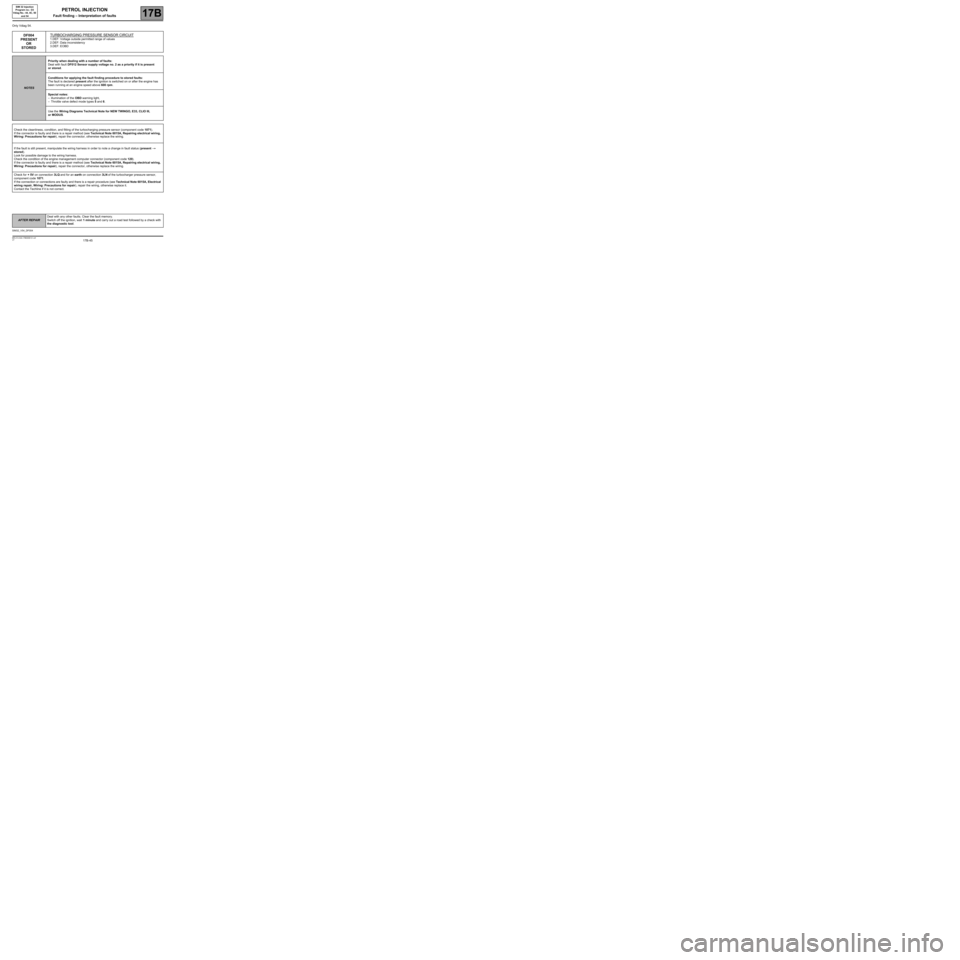
17B-45V7 MR-413-X44-17B000$131.mif
PETROL INJECTION
Fault finding – Interpretation of faults17B
SIM 32 Injection
Program no.: D3
Vdiag No.: 44, 4C, 50
and 54
Only Vdiag 54.
DF004
PRESENT
OR
STOREDTURBOCHARGING PRESSURE SENSOR CIRCUIT
1.DEF: Voltage outside permitted range of values
2.DEF: Data inconsistency
3.DEF: EOBD
NOTESPriority when dealing with a number of faults:
Deal with fault DF012 Sensor supply voltage no. 2 as a priority if it is present
or stored.
Conditions for applying the fault finding procedure to stored faults:
The fault is declared present after the ignition is switched on or after the engine has
been running at an engine speed above 600 rpm.
Special notes:
–illumination of the OBD warning light,
–Throttle valve defect mode types 5 and 6.
Use the Wiring Diagrams Technical Note for NEW TWINGO, E33, CLIO III,
or MODUS.
Check the cleanliness, condition, and fitting of the turbocharging pressure sensor (component code 1071).
If the connector is faulty and there is a repair method (see Technical Note 6015A, Repairing electrical wiring,
Wiring: Precautions for repair), repair the connector, otherwise replace the wiring.
If the fault is still present, manipulate the wiring harness in order to note a change in fault status (present
→
stored).
Look for possible damage to the wiring harness.
Check the condition of the engine management computer connector (component code 120).
If the connector is faulty and there is a repair method (see Technical Note 6015A, Repairing electrical wiring,
Wiring: Precautions for repair), repair the connector, otherwise replace the wiring.
Check for + 5V on connection 3LQ and for an earth on connection 3LN of the turbocharger pressure sensor,
component code 1071.
If the connection or connections are faulty and there is a repair procedure (see Technical Note 6015A, Electrical
wiring repair, Wiring: Precautions for repair), repair the wiring, otherwise replace it.
Contact the Techline if it is not correct.
SIM32_V54_DF004
AFTER REPAIRDeal with any other faults. Clear the fault memory.
Switch off the ignition, wait 1 minute and carry out a road test followed by a check with
the diagnostic tool.